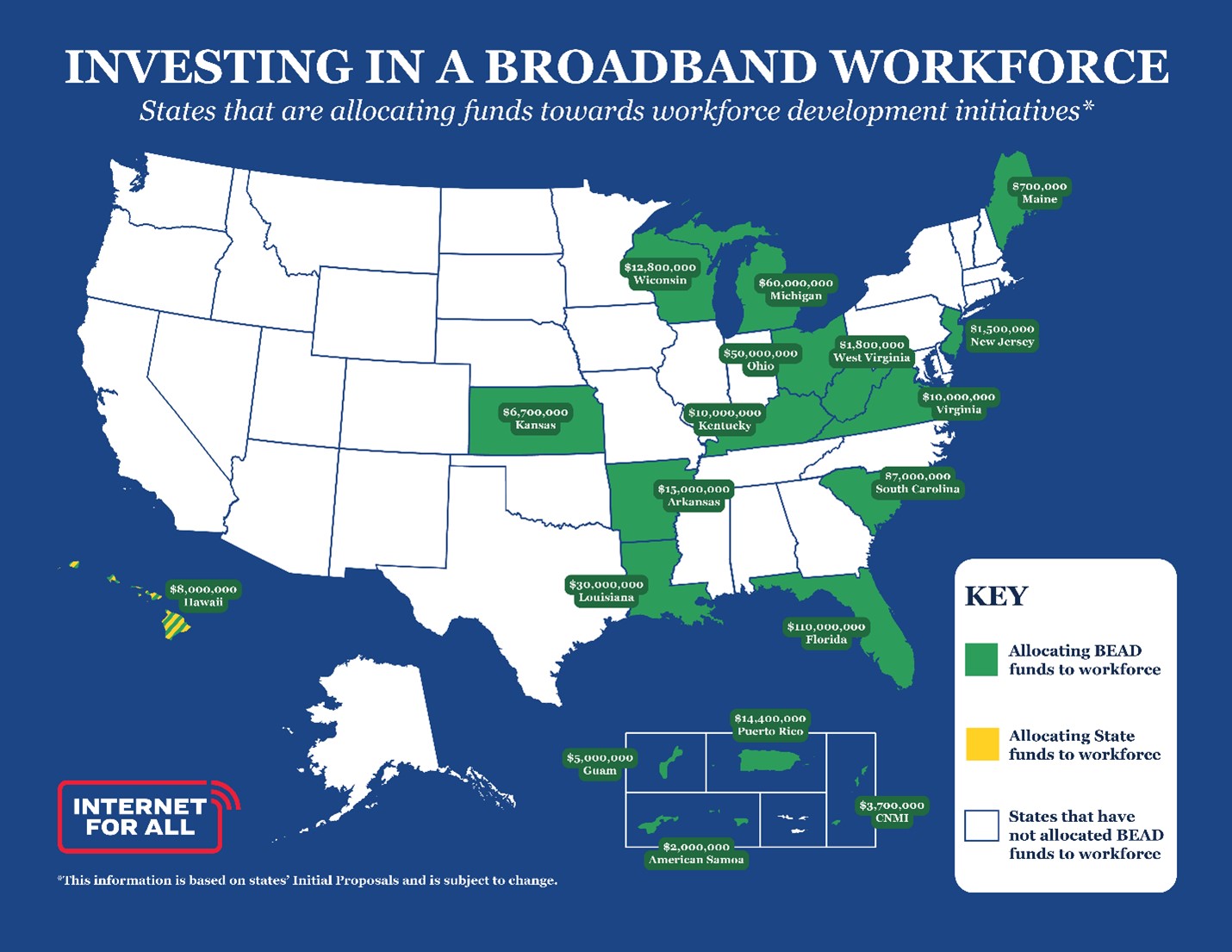NTIA Blog
Ramping Up the BEAD Workforce: 5 Things States, ISPs, and Construction Firms Can Be Doing Now
By: Will Arbuckle, Senior Policy Advisor, NTIA
The $42.45 billion Broadband Equity, Access, and Deployment (BEAD) Program aims to connect 25 million Americans currently without high-speed Internet access. Building these broadband networks on time and at scale across 56 states and territories will require tens of thousands of broadband construction workers: from network designers to pole surveyors, from locators to drill operators, from general laborers to fiber splicers.
Establishing partnerships as well as initiating and administrating education and training that prepares individuals to be effective across this spectrum of jobs can take between 9 months to 1 year. NTIA encourages grantees to act now to ensure workers are on board and trained so that BEAD deployment remains on track. NTIA will continue to support grantees as they move from planning to implementation.
Every state and territory’s BEAD Initial Proposal includes a workforce readiness plan. And so far, more than 30% intend to allocate nearly $350 million in BEAD funding to support broadband workforce development initiatives. For example:
The .com Cooperative Agreement: Ensuring Internet Stability and Security
Celebrating Native American Heritage Month: Empowering Native Communities Through Digital Equity
Every State and Territory is Ready to Implement Internet for All
Talking on the Moon: How Spectrum Research Will Shape the Next Era of Space Exploration
Three Years of High-Speed Internet Infrastructure Investment
Connecting Communities, Protecting Wildlife
Routing Security: A Call to Action for Federal Agencies
By: Robert Cannon, Senior Telecommunications Policy Analyst
Securing our nation's cyber infrastructure is imperative. That is why all Department of Commerce networks have taken the first step to implement Internet routing security.
Routing security ensures that Internet traffic reaches its intended target. Misconfigurations or manipulations of routing information can lead to significant degradation and loss of service.
The United States Government is tackling concerns about routing security through a whole-of-government approach. The Department of Commerce is playing a leading role in these efforts:
Peaceful Coexistence within the Radio Spectrum
By: Dr. Chris Anderson, Institute for Telecommunication Sciences (ITS), Theory Division Chief
In an increasingly congested wireless spectrum, conflict is both inevitable but often resolvable.
Between commercial applications (e.g., terrestrial and non-terrestrial wireless communications, navigation, and telemetry), scientific activities (e.g., radio astronomy, polar research, earth observation), and other vital spectrum-dependent uses (e.g., air traffic control), competition for spectrum access will only increase with new and emerging applications and technologies.
Finding ways to create additional access to this limited and valuable resource thus comes with many potential benefits, including faster, higher capacity and lower latency communications; new astronomical and scientific discoveries; more energy-efficient cities; increased highway capacity and safety; and more accurate weather predictions.
One important way to achieve these benefits is to integrate coexistence measures into spectrum-using applications at an early stage. This includes greater use of dynamic spectrum sharing systems, which enable spectrum users to operate safely in close proximity—whether geographically or in frequency—without causing harmful interference. Additionally, it involves enabling spectrum users to share spectrum access more rapidly than is currently possible with traditional and largely manual spectrum management approaches.
Advancing Innovation in a Software-Enabled World: Decoding the Complex Section 1201 Rulemaking
By: Luis Zambrano Ramos, Acting Deputy Associate Administrator, Office of Policy Analysis and Development, NTIA
Every three years, the U.S. Copyright Office reviews and occasionally recommends expanding legal protections rooted in Section 1201 of the Digital Millennium Copyright Act of 1998 for circumventing access controls on copyrighted works. Last week, the Copyright Office concluded its most recent review and issued its recommendations.
NTIA congratulates the Copyright Office and the Librarian of Congress on completing this important rulemaking, which can help prevent copyright law from getting in the way of vehicle repair, film studies classes, and a plethora of other important activities. We also support the Librarian of Congress’ conclusion that there are issues involving copyright-protected technology that “may require a broader solution” beyond this process.
Why a Triennial Review?
Because more and more devices have embedded software, this Section 1201 proceeding affects a range of activities, including security research, unlocking cellphones to switch wireless carriers, and repairing products.

